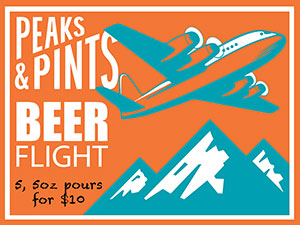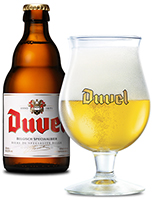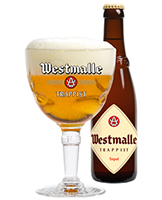 Today isn’t just Friday. It’s Belgian National Day. That’s right — as if anyone ever needs another reason to tip back a delicious brew (responsibly, of course), today sounds like an outstanding day to unwind after work without the slightest bit of guilt. Yes, today is Belgium’s National Day — a celebration that dates back 186 years, to July 21 1831, and the happy moment when Leopold of Saxe-Cobourg swore allegiance to the Belgian constitution, and became the first king of a newly forged European country. In Belgium, the anniversary will be marked with wild scenes and general merriment — or, at least, a few beers and maybe a walk in the park — from Antwerp to Zaventem. At Peaks and Pints, the anniversary will be marked by Carnivale de Belgian Beerloo, a Belgian beer tap takeover with Merchant du Vin Artisanal Imports, Total Beverage Solutions, Radeberger Gruppe and the Gritty City Sirens Burlesque Troupe. In conjunction with the Belgian draft beer and tassels at 6 p.m. tonight we present an all-day Belgian beer flight we call Craft Beer Crosscut 7.21.17: A Flight of Belgian National Day.
Today isn’t just Friday. It’s Belgian National Day. That’s right — as if anyone ever needs another reason to tip back a delicious brew (responsibly, of course), today sounds like an outstanding day to unwind after work without the slightest bit of guilt. Yes, today is Belgium’s National Day — a celebration that dates back 186 years, to July 21 1831, and the happy moment when Leopold of Saxe-Cobourg swore allegiance to the Belgian constitution, and became the first king of a newly forged European country. In Belgium, the anniversary will be marked with wild scenes and general merriment — or, at least, a few beers and maybe a walk in the park — from Antwerp to Zaventem. At Peaks and Pints, the anniversary will be marked by Carnivale de Belgian Beerloo, a Belgian beer tap takeover with Merchant du Vin Artisanal Imports, Total Beverage Solutions, Radeberger Gruppe and the Gritty City Sirens Burlesque Troupe. In conjunction with the Belgian draft beer and tassels at 6 p.m. tonight we present an all-day Belgian beer flight we call Craft Beer Crosscut 7.21.17: A Flight of Belgian National Day.
 Lindemans Peche
Lindemans Peche
2.5% ABV, 10 IBU
Indigenous to the Senne Valley of Belgium, lambics stem from a farmhouse brewing tradition several hundred years old. These brews are spontaneously fermented — meaning pots containing the wort are left outside and uncovered, allowing whatever critters happen to be flying by on a passing breeze to ferment the beer. These wild yeast give lambics their distinct tartness. Most Belgian brewers also utilize aged hops, which add antibacterial properties to the beer, rather than bitterness or flavor. In the case of fruit lambics, whole fruits are traditionally added after halfway through fermentation to add sweetness and new dimensions of flavor as Lindemans did with their Peche (peach). Lindemans, a family Belgian brewery since 1822, brews a peche that smells like peach cobbler. We braced for that bubblegum-like flavor of many fruit-infused beers, but instead are greeted with a sugary, sweet peach flavor that races happily through our mouth on soft, bubbly carbonation. A quiet tart note in the finish keeps the beer from becoming too cloying. It’s a simple treat that’s easy to drink, especially if you love fruit beers.
 Dupont Avec Les Bons Voeux
Dupont Avec Les Bons Voeux
9.5% ABV, 28 IBU
In January 1970, Belgian brewery Brasserie Dupont needed a gift to dole out to key clients. Key chains just weren’t going to cut it. Since the brewery produces amazing ales they thought why not gift an ale: Avec Les Bons Voeux, which translates as “with best wishes.” It blew minds. Dupont eventually released it commercially, albeit in limited quantities. A blond ale boasting a hefty 9.5-per-cent alcohol, it pours with a hazy tint and is almost buttery-smooth in texture. There’s mellow fruitiness and yeasty bread flavor at its core, with lively clove and licorice notes folded in, set against a solidly bitter backbone.
 Duvel
Duvel
8.5% ABV, 33 IBU
Duvel Moortgat’s Belgian is considered the archetype of the Belgian strong golden ale category. The yeast — the fruity esters, imparts the distinctive characteristics of any Belgian beer and spicy phenols created during fermentation are the major draw for drinkers. Anyone looking for these traits in Duvel will not be disappointed. Duvel is brewed with Pilsner malt and dextrose, and hopped with Saaz and Styrian Golding, the yeast still stems from the original culture of Scottish yeast bought by Albert Moortgat during a business tour of the U.K. just after World War I. The nose is an equal, subtle blend of white pepper, coriander, tangerine peel, and pear juice; the flavor mixes spice rack stuff (coriander, clove, and white pepper) with sweet blasts of pears and apples before a slightly drying, bread-y finish.
 Rodenbach Grand Cru
Rodenbach Grand Cru
6% ABV, 35 IBU
Flanders red ale is a style of sour ale brewed in West Flanders, Belgium. Flanders red ale is aged in oak barrels with Lactobacillus and Brettanomyces that add yogurt tang and barnyard notes and Acetobacter, which is the bacterium that creates vinegar. Consequently, Flanders red ales have sharp acidic, vinegar notes. Coming out of west Flanders is the World Beer Cup gold medal-winning Rodenbach Grand Cru, a blend of “young” beer (33%) and an older beer (67%) that has matured in oak vats. It is the high percentage of the older ripened-in-oak beer that gives it the complex and intense bouquet with a very long aftertaste like a Grand Cru wine. The late Michael Jackson bestowed upon this beer the titles of “World Classic” and “the Burgundy of Belgium.
 Brouwerij der Trappisten van Westmalle Tripel
Brouwerij der Trappisten van Westmalle Tripel
9.5% ABV, 36 IBU
In 1836 the Belgian Westmalle monastery became a Trappist Abbey and began brewing beer shortly thereafter. The holy suds they produced started out as an insider-only deal — a choice beverage to be made and enjoyed by Trappists and Trappists alone, but eventually they decided to expand and opened up a public beer hall in the early 1930s. Westmalle embodies the tripel style with a thoughtful balance of sweet, fresh pear, lemon zest and a dash of peppery spice. Its flirtatious effervescence sweeps the mouth clean, while lingering lemony hops leave the mouth pining for more. It’s an exceptional beer, with a great deal of finesse and elegance and a splendid enduring aftertaste.
